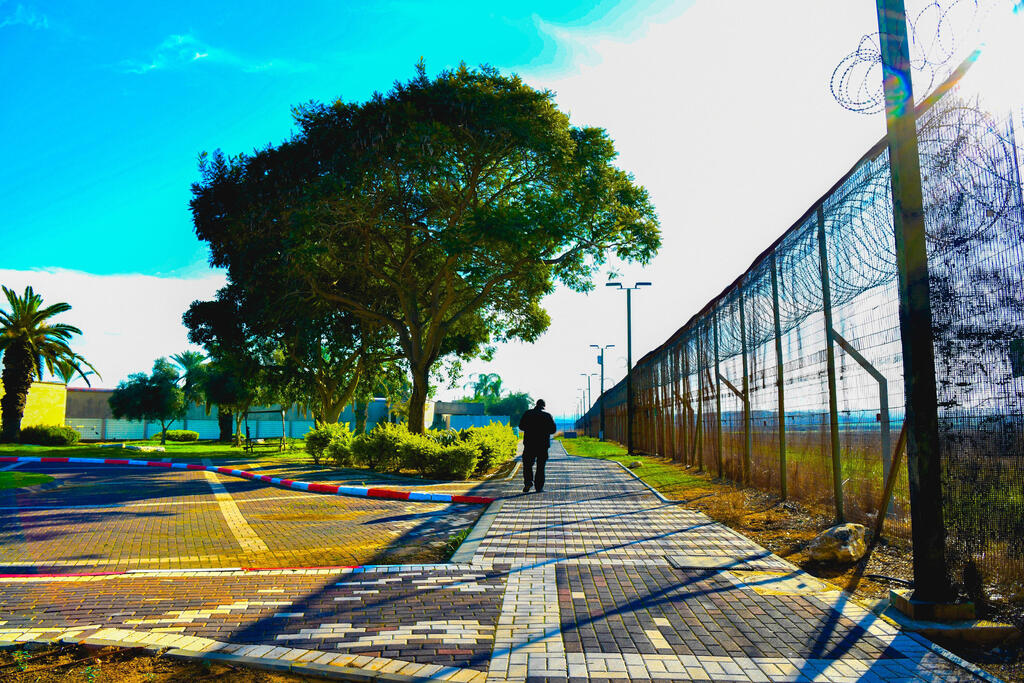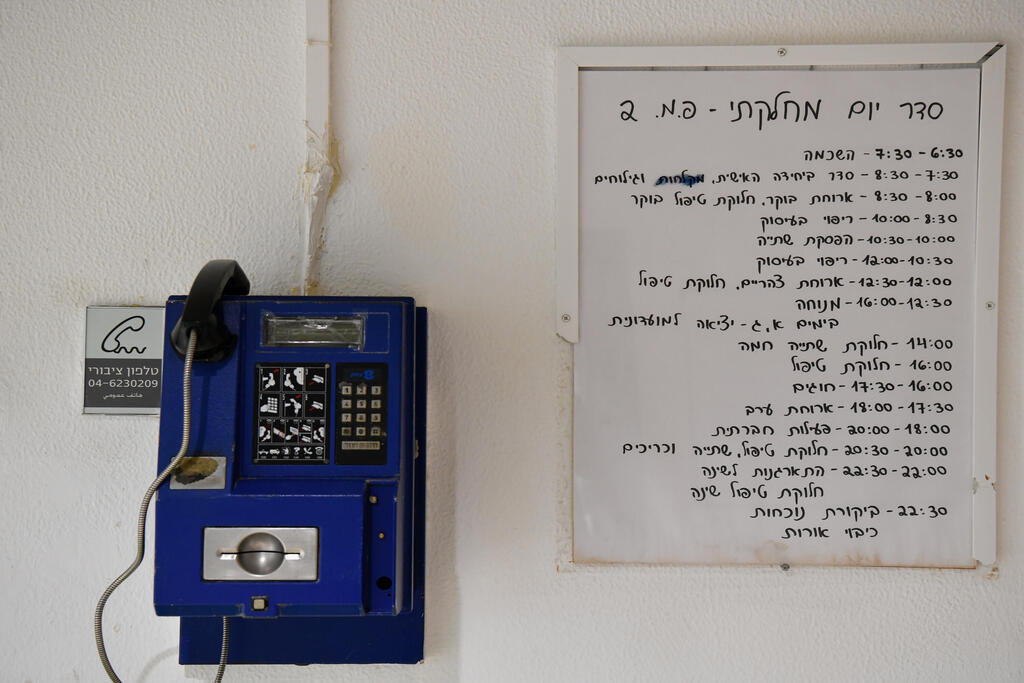The road from the highway is breathtaking, surrounded by trees and fields. On a clear winter day, the lush, blooming scenery abruptly changes at the entrance gate to the Maximum Security and Forensic Psychiatry Division at the Sha’ar Menashe Mental Health Center.
Amid tranquil fields, a high concrete wall surrounds the facility, topped with barbed wire and even a watchtower. This is the only facility in Israel reserved exclusively for the most violent of patients. One in four has committed or attempted murder.
14 View gallery


A rare glimpse into the facility housing the country's most dangerous psychiatric patients
(Photo: Nachum Segal)
Some have been involuntarily committed under court order, while others have been transferred from other psychiatric wards across the country unable to manage their aggression.
Avner (a pseudonym), about 45 years old, describes the circumstances that brought him here. "I’ve been hospitalized here under a court order for 25 years because I killed my mother. My father disowned me. I’ve been here for six and a half years after serving four months in prison. I committed a crime, and I have to be punished," he coldly details the horrific act he committed. "The staff here treats me well and speaks to me very kindly. I behave well now, I don’t hit anyone."
Dr. Ronen Huberfeld, deputy director of Sha’ar Menashe, explains that the forensic psychiatry division comprises four identical wards, each housing 32 men, totaling 128 patients. About a third are hospitalized under orders from a regional psychiatrist, while two-thirds are under court-mandated hospitalization after committing a criminal offense in a psychotic state. Around five percent are there under observation orders.
14 View gallery


Each room houses two residents, with all furniture bolted to the floor
(Photo: Nachum Segal)
The verdant, well-maintained courtyard serves all four heavily secured wards. It includes a basketball court, fitness equipment and fixed wooden benches and tables.
For over a decade, Dr. Evgeny Shnarenko has managed "Forensic 2," one of the four wards at the facility: "I came here out of curiosity after managing an active closed ward. My challenge was to treat patients so violent and dangerous that psychiatry had given up on them. That’s why I came here, to try something different."
We began the rare tour of the ward in patient rooms, which appeared orderly and clean. Each room houses two residents, with all furniture (bed, closet, small table) bolted to the floor to keep it firmly in place. This precaution is not theoretical—it is a sad and concerning reality. Upon entering the ward’s main area, attention is drawn to the stocky security guard standing outside the nurses’ station and the distress buttons worn by the staff.
Restraint is used only as a last resort
One patient pulled the hinge off a cabinet door and fashioned it into a brass knuckle, which he used to attack a staff member. In one of the isolation rooms located along the ward’s corridor and locked with a barred door, a patient managed to rip out a security camera installed near the ceiling. "One particularly violent patient was kept in isolation for a month, and during one incident, when staff entered the room, he violently attacked one of us," recounts Dr. Shnarenko. "Other patients rip out sharp pieces of Formica from tables and use them to shank staff and fellow patients. Verbal and physical violence is common among them."
In the isolation unit, a shower and toilet have been installed to avoid the risk of moving the patient out for such needs. "One patient was placed in isolation because he would attack whenever he heard voices. We taught him to sit down whenever he heard them, and this successfully neutralized his aggression," the ward manager shares.
Patients going through extremely violent episodes who don’t respond to attempts by staff to calm them are moved to a restraint room—often called a "restraint room" in psychiatric terms—as a last resort.
14 View gallery


'My challenge was to treat patients that psychiatry had given up on': Dr. Yevgeny Shankarenko at the entrance to the isolation room
(Photo: Nachum Segal)
In plain terms, this is a room for physical restraint where the patient is strapped to a bed in the center of the room. A television and a camera allow nursing staff to constantly monitor the patient during their stay. "When a patient poses a danger to themselves or others and becomes uncontrollably agitated, only then do we use restraints as a last resort and for a short duration," emphasizes Dr. Huberfeld.
In his office, the ward manager describes the patient demographics: "Fifty percent are schizophrenic, and the rest suffer from bipolar disorder (manic depression) often linked to drug use or from schizoaffective disorder (a mental illness involving symptoms of schizophrenia coupled with bipolar mood episodes). Some were admitted after committing murder or attempted murder, most often within their families, and in the vast majority of cases, they murdered their mothers."
14 View gallery


'Restraints are used as a last resort and for a short duration': A containment room
(Photo: Nachum Segal)
The forensic psychiatry division reflects the full spectrum of Israeli society, including individuals from all religions. The longest-residing patient here has been hospitalized since before 1997, and many have been here for over a decade, the ward manager explains. Like other hospitals, this ward operates at full capacity year-round. "When psychiatric wards across the country cannot handle an exceptionally violent patient and wish to transfer them here, or when a compulsory hospitalization order is issued for a patient who has committed a crime, we do not add extra beds. It’s well known that overcrowding fosters violence. Instead, we transfer the least complex patient back to their originating ward or to another closed ward within Sha’ar Menashe," describes Dr. Huberfeld.
'We don’t claim to cure'
Beyond the professional challenges, Dr. Shnarenko speaks about the understaffing and the effort required to provide care under substandard conditions: "The forensic ward, where the most violent and challenging patients are admitted, operates with two full-time doctors, one part-time doctor, six nurses per morning shift, a psychologist, two psychology interns, a social worker, an art therapist, a criminologist, support staff, and security guards. Together, we function as an intensive psychiatric care unit aimed at stabilizing and calming the acute illness, but we don’t claim to cure it."
14 View gallery


Jana Garlin Zaitsev and Moshe Geta, who is replacing her as the head nurse. From here, they monitor the department through closed-circuit cameras
(Photo: Nachum Segal)
We wondered if someone under observation could feign a psychotic state to avoid prison. "A person can’t pretend for an entire month because they’re monitored 24/7 by staff and through the cameras at the nurses’ station. They can say a thousand times that they’re hearing voices," says Dr. Shnarenko.
Every Monday, Atara Blau, a therapeutic dog handler, arrives with her two trained dogs, Felipe and Kotak. The session begins with the dog approaching each patient who wishes to interact, offering its paw. Later, the patients play fetch with the dog. "What do you like about dogs?" Blau asks. "They calm me down; they remind me of my dog," one patient replies.
This session is just one of the tools the staff uses to care for patients, many of whom made headlines for the heinous murders they committed. The ward provides them with medical and psychological support, as well as social activities, and even allows outings beyond the division’s walls and barbed wire.
"We do everything we can to stabilize and ease the patients’ conditions while preserving their basic dignity and rights. For example, we allow them to keep mobile phones without cameras and cigarettes, which are lit using a wall-mounted lighter. A staff member accompanies each patient who smokes outdoors. To instill routine, we enforce a structured daily schedule that requires them to get out of bed, partly to protect the cleaning staff from them," Dr. Shnarenko explains. He also aspires to introduce the conjugal visit model common in prisons, noting, "Such meetings are known to calm patients and reduce aggression levels."
14 View gallery


'The dogs calm me down; they remind me of my own dog,' says one of the patients
(Photo: Nachum Segal)
Many patients eagerly await the weekly art therapy group led by Yifat Kates, an art therapist. "This is the only art therapy group in the world composed entirely of murderers," says Dr. Shnarenko. The group, running for seven years, is the longest-standing program in the ward. "It allows patients to express themselves in a language beyond words, which can sometimes be inaccessible to them. They manage to bring forward elements of curiosity, memories, longing, and tell their stories beyond their illness and the reasons for their hospitalization," Kates explains.
'Placing the keys in your hands'
Sharon (a pseudonym), a 37-year-old patient, speaks eloquently and coherently about his illness: "I’ve been here for seven months. This is a supportive ward that’s gradually helping me prepare for the outside world. Schizophrenia disconnects me from reality, and I live in a virtual world, caught between reality and madness. In my previous hospitalizations, I resisted the psychiatric system, but here, I no longer fight it. They’ve given me tools not just to contain me but to strengthen me." When he first arrived, Sharon recalls saying to Dr. Shnarenko, "I’m placing the keys to my life in your hands."
Five months after his condition was stabilized, Sharon was allowed to leave the hospital grounds accompanied by a friend. "My episodes always come around the holidays. It starts with a sense that everything is fine, that the world is alive and I feel it, but then there’s a crash. After every episode, I have to start my life all over again."
14 View gallery


From right: Liran Norik, Moshe Geta, Tzlil Ariev Erez, Jana Garlin Zaitsev, Dr. Yevgeny Shankarenko, and Yifat Keitz
(Photo: Nachum Segal)
“Open the computer,” Sharon tells the ward manager, “and write down that I’ll be back here after the next holiday.” Like Sharon, others also return for hospitalization. Avner was offered a transfer to a rehabilitation ward but asked to stay in the "greenhouse" of Forensic 2.
The staff refuse to give up on any patient, navigating the complex path to help each one. "In our multidisciplinary discussions, we mainly focus on the patients who are most stuck, the ones we haven’t managed to progress with yet," says Tslil Aryav Erez, the ward psychologist.
Get the Ynetnews app on your smartphone: Google Play: https://bit.ly/4eJ37pE | Apple App Store: https://bit.ly/3ZL7iNv
"When some patients reach awareness and understand the act they committed, post-trauma often develops. Together, we process the events of the murders. Most of the patients come from difficult social backgrounds and have endured complex experiences in childhood, during which their mental disorder often began, eventually worsening into severe illness."
She continues, "The patients in this ward receive long-term psychological therapy, during which they experience positive relationships that allow them to process everything they’ve been through. Our primary goal is to provide each of them with a safe space to express every part of themselves, to meet the person they are—not just their illness but everything beyond it."
Family visits are rare
Most patients do not receive family visits. "The patient caused a terrible tragedy in their family, so the family distances themselves," explains Liran Norik, a social worker in Forensic 2 responsible for maintaining delicate connections with relatives. "I reach out to families who are still very angry and ask for background information about the patient. Later, I tell them that I need their help to assist their sick family member."
14 View gallery


Most patients come from difficult social backgrounds. Behind the gates and doors
(Photo: Nachum Segal)
Dedication despite violence
Despite the high level of violence directed at them, the staff remain loyal to their roles. As Prof. Mickey Dudkiewicz, the director of Sha’ar Menashe, notes, nearly every day, a patient strikes or injures a staff member. "I’ve been a nurse for six years. My first job was in an internal medicine department, but after a year, I realized it didn’t interest me. I moved to a closed acute ward, which was like a revolving door: patients would come in, get treated, improve, be discharged, and then return a few months later. I transitioned to forensic psychiatry, and every morning, I come to work with a smile," says Moshe Gata, the new ward head, replacing Jana Gerlin-Zaitsev, who is retiring.
"I meet the patient at the entrance gate, still in the ambulance or police van, and accompany them throughout the long process of change," Moshe explains. Even after being violently attacked by a patient who broke his nose, Moshe continues his work. "I love my job. I don’t insist when a patient refuses a blood test. My satisfaction comes from every distraction I can provide to a violent patient—taking them for coffee and a cigarette with a security guard or offering them an ice cube to chew on. I use any other regulating tool to avoid restraint."
14 View gallery


'The main challenge is to build trust': Jenny Segalovich, head nurse
(Photo: Nachum Segal)
Jenny Segalovitz, head of nursing at the hospital, adds: "The main challenge for psychiatric nurses, especially in the forensic ward, is building trust with the most complex patients in the system. We have to convince them that a simple blood test isn’t meant to drain all their blood and that the medications they think are poison aren’t harmful. In such cases, we don’t argue with their distorted thoughts. Instead, I and the nurses say, ‘I know these are your thoughts, but in reality, I’m Jenny, a nurse, and all I want is to care for you.’”
Turning straw into gold
The staff here are marathon runners, not sprinters, and they don’t believe in quick fixes. "We live for tiny achievements," they all attest. "The challenge is to take a patient stuck in a hopeless dead-end and move them forward," says Dr. Shnarenko.
14 View gallery


From right: Dr. Muli Linder, Prof. Miki Dudkevich, Dr. Ronen Huberfeld
(Photo: Nachum Segal)
14 View gallery


'Some patients develop PTSD as they process their actions': Psychologist Tzlil Ariev Erez
(Photo: Nachum Segal)
Not far from the forensic ward lies Israel’s only psychiatric rehabilitation unit of its kind. This facility provides patients with controlled and manageable conditions and a gradual and extended transition back to life outside. After learning to manage themselves and their illness, patients here live in a type of shared housing. Some will eventually move to hostels, while others may return to psychiatric wards or even re-enter Sha’ar Menashe in a revolving-door cycle.
Sha’ar Menashe Mental Health Center, the largest hospital in Israel by area, spans 720 dunams (more than Sheba Medical Center). It is managed by Prof. Mickey Dudkiewicz, who also oversees Hillel Yaffe Medical Center in Hadera. "I marked managing a psychiatric hospital as a challenge for myself even before I arrived, and I learned along the way," he explains. "For example, one of the first changes I implemented was to increase the number of security personnel from 15 to 50. However, during wartime, when some were called up for reserve duty, we found ourselves short-staffed again."
As he delved deeper into the complexities of the hospital, the shortage of human resources across all levels became evident. "Despite these gaps, our patients—many of whom are smokers and already suffering from high blood pressure and other illnesses—receive top-quality medical care in all areas."
The stigma long associated with psychiatry has begun to fade, particularly during the recent "Iron Swords War," when the critical role of this specialty became apparent. "October 7 changed something and elevated the prestige of psychiatry," says Dr. Muli Linder, Deputy Director of Sha’ar Menashe. "Awareness of its importance has risen, and initial estimates indicate a massive number of mental health casualties who will develop post-trauma."
Dr. Linder distills the work of psychiatrists at Sha’ar Menashe into a vivid analogy: "It’s like being Rumpelstiltskin, taking a pile of straw and trying to spin it into gold."




